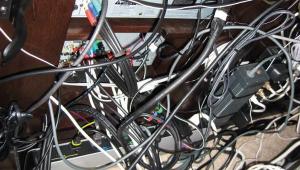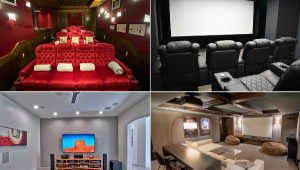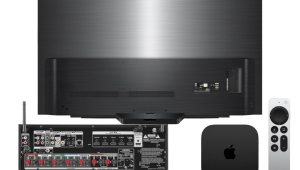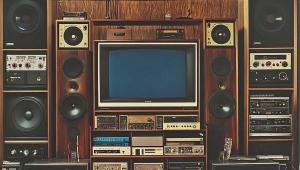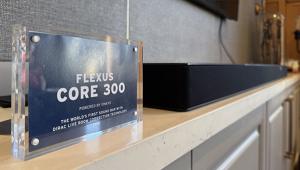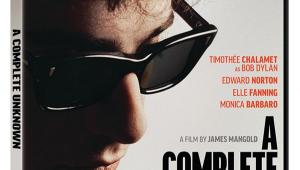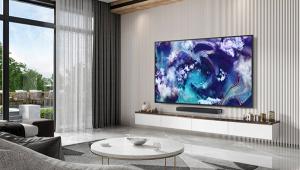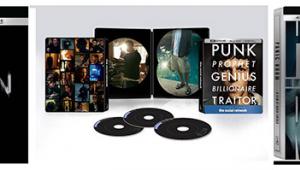I just wanted to address the HDMI 1.0 issue. The HDMI version on the display is completely irrelevant in this case. The BD player will feed HDMI to the Denon 2308 (although player must be set to transcode TrueHD/DTS-Master to PCM), then the picture information is sent from the 2308 to the display. No audio is going through the display!
Sub Size, Upscaling, Blu-ray

What is the recommended size for a subwoofer in a room measuring 19x17 feet? How big does the sub need to be for home theater?
Harry Rutgers
The size of the subwoofer is far less important than where you place it and where you sit, though in very general terms, the larger the room, the larger the sub needs to be to fill that room. Your room is of moderate size, so any sub of moderate size will be fine.
I recommend thinking more about where to put the sub. According to one approximation determined by master acoustician Floyd Toole, the sub should normally be placed at the half or quarter point along one wall. (In the diagram above, the depicted side-wall positions are a bit off-center.)
Also, your seats should not be at even fractions of the room's dimensions (half, quarter, etc.) in order to avoid the inevitable dips and peaks at certain low frequencies that occur at those locations. Neither should your seats be placed right up against a wall because the bass will inevitably be too loud and boomy there.
The procedure to find the best location for the sub in a particular room is rather involved. One technique is called the "subwoofer crawl," which goes like this: First, place the sub at your listening position and play some familiar music. Then, crawl around the perimeter of the room to find the spot at which the bass sounds the most smooth and even. That's the place to put the sub, which will then produce the most even bass at your listening position.
Are You Kidding?
Is video upscaling just a gimmick? One of our source devices is a Toshiba HD DVD player that is supposed to upscale standard-definition DVDs to 1080, but 90 percent of the time, we get a message to the effect of, "Upscaling is prohibited for this content, playback will be limited to 480." I think that upscaling is a gimmick that cheats by making educated guesses about the pixels it is "filling in," but I feel kind of cheated by this supposed feature.
Scott Ward
I strongly disagree that video upscaling is just a gimmick. It's important to upscale a standard-def image to the resolution of the display; otherwise, the image would occupy only a small portion of the screen. Yes, it's "guessing" what should be in the pixels it creates to fill in between the actual data, but this can be done fairly well these days. Of course, some products do it better than others, but this is always the case.
Regarding the HD DVD player, are you using its component-video output? If so, that's your problem—HD DVD players won't upconvert DVDs to 1080i or 1080p for output via component; they will only output 480p via component. They will upconvert to 1080p via HDMI, so use that connection if possible. If you must use component, the signal will be upscaled by an HD display anyway.
Blu-ray Quandary
I have a Hitachi 57F59A RPTV that can accept 1080i but not 1080p. It has the older HDMI 1.0 and component inputs. Would I notice a big upgrade in picture quality with Blu-ray even though my TV isn't 1080p and only has the older version of HDMI? Is 1080i at least better than 720p? Also, would the older HDMI even past the new Dolby TrueHD and DTS-HD signals, or would I have to go 6-channel analog out to my Denon AVR2308 receiver?
I noticed at Target that the new Star Trek movie was $14.99 on DVD, but the cheapest Blu-ray edition was $29.99, and all the Blu-rays were twice as much as their DVD counterparts. Is Blu-ray really twice the picture quality of DVD, even on my TV, or would I need to upgrade my TV to see any big difference?
Even though I'm not a gamer, I was thinking of getting the Sony PS3 for watching Blu-ray movies since the price was recently dropped. But is the new smaller, cheaper PS3 still as good as the original, and does it have all the features of the original, or did they cut features when they cut the cost and made it smaller?
Tim Neal
First of all, your TV is CRT-based, which probably means it displays a high-def image with 1080 horizontal lines in an interlaced fashion—that is, it "draws" the odd-numbered lines followed by the even-numbered lines. Thus, it theoretically has the same resolution with a 1080i or 1080p signal, but it cannot accept a 1080p signal, so if you get a Blu-ray player, you will have to set it to output 1080i. You might or might not see deinterlacing artifacts depending on the TV's internal video processor.
In my opinion, you will see a marked improvement in picture quality from Blu-ray compared with DVD. Will to be twice as good? Perhaps not, but it will be clearly better. Also, I think 1080i is generally better than 720p from a Blu-ray player, especially when feeding a display with 1080-line resolution, because sending 1080i avoids two scaling stages—one in the player going from 1080p on the disc to 720p before outputting the signal, and the other in the TV going back to 1080p.
No version of HDMI before 1.3 can accommodate Dolby TrueHD or DTS-HD. A 6-channel analog connection can, but none of the Sony PS3 models have such an output. (Otherwise, they are excellent Blu-ray players.) Other dedicated Blu-ray players do have these outputs, and many can be found in the $200 range.
As for the PS3, Home Theater reviewer David Vaughn says the new model is even better than the original—much quieter in terms of physical noise and no compromise in terms of picture and sound quality. Sony eliminated the emulator chip, so the new model can't play PS2 games as the original could, but since you're not a gamer, that's not an issue. Also, it has two fewer USB ports and no on/off switch on the rear, but again, these are no big deal in my book.
BTW, I've seen Star Trek on Blu-ray for $19.99 at Amazon and Walmart.
If you have a home-theater question, please send it to scott.wilkinson@sorc.com.
- Log in or register to post comments

To Scott Ward: To add to what Scott (Wilkinson) said about the upscaling question...If you use a component video connection to a disc player that utilizes an HDMI port for video scaling "Up to 1080p," you will only get the 480i or 480p playback due to copyright protection. I've done this test many times to determine the effectiveness of the built in scalers on A/V Receivers from many different brands. I have yet to find a player that will upscale a Copywritten signal beyond 480p off of a Component video connection.To address video scaling further, I would continue to agree with Mr. Wilkinson in that it is a very important feature on our digital devices. Heck look at the new Toshiba CELL TV that will be able to "upconvert" 2D images to 3D in this upcoming year!!! That's pretty incredible. But for todays stuff, if you want your picture to look as good as it can all the time, a Video Processor will get you the best picture possible (short of investing in some SERIOUS sour

I'm not so sure Mr. Wilkins is correct in his statement about the Sony PS3 not having the capability to output in Dolby TrueHD or DTS-HD. According to cnet's Matthew Moskovciak, the new PS3 Slim model "can bit stream both Dolby TrueHD and DTS-HD Master Audio. That change actually isn't that surprising, since the original limitation on the "old" PS3s was due to an older HDMI chipset; newer HDMI outputs have no problem bit streaming the high-resolution soundtrack formats."They don't mention HDMI 3.1 but think about it, why would the PS3 be capable of sending out a Dolby TrueHD/DTS-HD bitstream if it's HDMI cable couldn't carry it?Link (cnet): http://news.cnet.com/8301-17938_105-10314795-1.html Engadget: http://www.engadget.com/2009/08/21/ps3-slim-bitsreams-dolby-truehd-and-d...

Gunhaver, in my reply to Tim, I didn't mention the PS3's ability to send Dolby TrueHD and DTS-HD, so I'm not sure what you're disagreeing with here. However, you are correct that the new PS3 can send these bitstreams, whereas the older PS3 cannot. I should have included that in my response.Adam, I'm not sure that all upscaling players limit the component output to 480p with copy-protected DVDs, but I can't think of any that don't off hand, so I'll take your word for it for now. I do seem to recall hearing of a player that upscales via component, but I can't remember the details. If I find it, I'll let you know.Tyler, you're right that the TV's HDMI version is irrelevant in this case, since it's not getting any audio. I was simply answering Tim's immediate question about older versions passing Dolby TureHD and DTS-HD. I should have pointed out what you did in your comment.

I am going to apologize for putting such a broad statement out there about the upscaling feature in DVD/blu-ray players. Broad statements in this game shouldn't EVER be said. However, like you said Scott, I can't think of a single unit that scales copywritten material beyond 480p over component video. And when I say a single unit, I'm pretty much speaking about EVERY mainstream model from SONY, PANASONIC, SAMSUNG, LG, PIONEER, DENON, MARANTZ, YAMAHA, HARMAN KARDON, ONKYO, and INTEGRA. I'm sorry that I have not been able to test other units from other brands, but these are the units that I've had access to in my A/V career over the last 5 years. If someone is aware of a unit that can scale Copywritten material over component video I would love to know! I would like to point out the fact that I have been able to scale non-copywritten material on nearly every LG player I've tested, along with various other players from other brands (but NOT NEARLY every model, as it has been with th

Ha! My mistake Scott, I totally misread your response. You were saying that a PS3 didn't have a 6-channel analog connection which of course is true. In my mind I was thinking you were referring to a Dolby HD capable output. I love this "Ask Home Theater" section by the way!

Hi Scott, What I also find interesting in this article is the DIAGRAM itself. I noticed on the backwall that the rear surrounds are placed together. On the THX website, this is shown as THE 7.1 configuration for the back speakers under Home Entertainment -> 7.1 Home Theater Set Up. (By the way, DTS also shows some other 7.1 configurations.) My question is this, I thought that the SMPTE & possibly the ITU would be in agreement and would want the configurations to be the SAME so the recordings would be consistent. To add more confusion to the topic, I always thought of THX to be an audio reference standard, and not a competing format such as DTS & Dolby. So when I see THX making layout recommendations like this? It gets confusing! I would love to learn more about this topic. Keep up the good work!

CJLA, there is no standard for where to put the back-surround speakers, so yes, the subject is indeed confusing!MartinLoganFan, thanks for providing an example of a DVD player that upconverts to 1080i via component. And I'm very glad you enjoy this blog!

Hi mr scott,Sub size matters? Um,i think it does.My uncle has a home with a 15x18 that opens to the kitchen area. Pretty big living room,he had a 8"audio source and properly balance. We notice the bass wasn't filling the hole room. So,i told him to upgrade to a 12" sub woofer from jbl. So once we got the new sub inplacen and properly balance it was night n day,so sub size matter. love your podcast. :)

I have a related question to the original. I have an aging but nice 1080i Pioneer Elite 62" projection TV (old style projection, not DLP) with DVI inputs but no HDMI and a Denon receiver that doesn't have HDMI on it. I am planning to get a BluRay player soon (either LG BD390 or Oppo BDP-83), then perhaps a new receiver (likely Integra DTR-40.1) in the next year or so, and eventually a new TV (58" plasma or LED, depending on price). Given this set-up and plan, I have two questions. First, can/should I connect the BluRay video signal directly to the TV with an HDMI-to-DVI cable and then use an optical digital cable to run the audio to the receiver? Second, given that I can't afford to buy everything right now, should I just wait to buy the BluRay player until I can also do the receiver or even all three at the same time?

